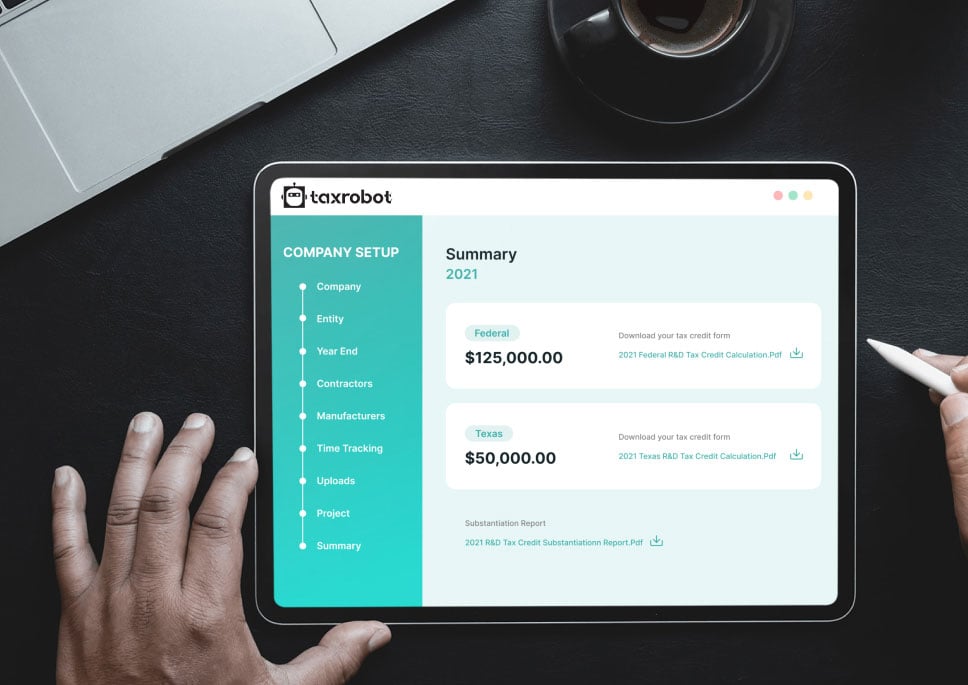Idaho R&D Credit
Maximize your tax savings with TaxRobot and the Idaho R&D credit.
Maximize your State Credits today!
Put the R&D tax credit process on autopilot.
Trusted By:








Idaho R&D Credit
Discover your eligibility for Idaho R&D tax credits and supercharge your enterprise.
Does Idaho Have R&D Tax Credits?
If you’re wondering if Idaho has an R&D tax credit available for businesses, you’re in luck. One of the many gems within the Gem State is a great tax credit program.
This program is based on the federal program, which is designed to reward businesses for innovation and investment. However, it has a few specifications that make it unique to Idaho.
Federal R&D Credit
Since the Idaho R&D credit is based on the federal R&D credit, we can start learning about it by digging into the federal credit. This credit is defined in section 41 of the IRS code.
The first part of this defines the credit as worth 20% of the excess qualified research expenses over the base amount. The section then goes on to fully define these expenses and explain that they have to be related to research, development, technology, and/or a number of related concepts. Finally, it explains some of the more exact details for calculating the credit.
Credit for Idaho Research Activities
Idaho uses the definitions of the federal R&D tax credit as the base of its own tax credit application. This means that it uses the same definition for what qualifies as research expenses. So, anyone interested in applying for the Idaho tax credit should fully understand the federal credit first.
The biggest difference is that the expenses that qualify for the Idaho credit must occur within Idaho. Alongside this, the credit rate changes to 5% of the current year’s qualified research expenses exceeding the base amount rather than 20%. In addition, the alternative simplified credit calculation, which is available for the federal credit, cannot be used for the Idaho credit.
On the plus side, the Idaho credit can be shared. On top of this, it is eligible to be carried over for 14 tax years, which is a major benefit in many cases.
How to Qualify for the Idaho R&D Credit
To obtain the Idaho R&D tax credit, a business needs to qualify for it. This means having a qualifying business and qualifying expenses.
Your Business
The nice part about the Idaho R&D tax credit is that many businesses qualify for or can qualify for it. C-corporations, S-corporations, LLCs, and partnerships can all qualify for the credit. They just need to meet the requirements. However, all of these requirements relate to the expenses.
Your Expenses
As already mentioned, qualifying expenses for this credit are the same as those that qualify for the federal credit, with the limit that they have to take place within Idaho. This is the most fundamental feature of this qualification.
The biggest caveat is that only technological activities qualify for this tax credit. So, companies doing research and development outside of technical fields will not qualify because their expenses won’t qualify. However, technology companies will find an easy time getting this credit.
Let TaxRobot Make It Easier to Claim the Idaho R&D Credit
The Idaho R&D tax credit is relatively straightforward because it relies so much on the federal credit. However, applying for it still requires a lot of knowledge about very specific rules. One needs to understand the federal credit in an in-depth way. Then, they need to be aware of all the small caveats and restrictions the Idaho credit places on this.
For this reason, trusting TaxRobot with all of these calculations is much easier. At TaxRobot, we specialize in this credit. We have a wealth of knowledge about the federal and Idaho credit. Alongside this, we have advanced software that assists us in creating perfect applications for the credit. With us, your R&D tax credit application is in good hands.
Find Out How Much You Could Save
Wondering how much the Idaho R&D credit could save you? Try out our calculator and see.
Take a sneak peak

- Limited Time Offer
- Simple Onboarding
- Easy to Use
R&D Tax Credits FAQs
The four-part test as outlined in the Internal Revenue Code is used to determine qualified R&D activity.
The Four-Part Test
1). New Or Improved Business Component
Creation of a new product, process, formula, invention, software, or technique; or improving the performance, functionality, quality, or reliability of existing business component.
- Construction of new buildings or renovation of existing buildings
- Invention of a software application
- Manufacturing of a new product or the improvement of the production process for an existing product
- Creation of design documentation
2). Technological In Nature
The activity fundamentally relies on principles of the physical or biological sciences, engineering, or computer science. A taxpayer does not need to obtain information that exceeds, expands or refines the common knowledge of skilled professionals in a particular field.
- Physics (relationship between mass, density and volume; loading as the
result of gravitational attraction) - Engineering (mechanical, electrical, civil, chemical)
- Computer science (theory of computation and design of computational systems)
3). Elimination Of Uncertainty
Uncertainty exists if the information available to the taxpayer does not establish the capability or method for developing or improving the business component, or the appropriate design of the business component.
- The capability of a manufacturer to create a part within the specified tolerances
- The appropriate method of overcoming unsuitable soil conditions during construction
- The appropriate software design to meet quality and volatility requirements
4). Process Of Experimentation
A process designed to evaluate one or more alternatives to achieve a result where the capability or method of achieving that result, or the appropriate design of that result, is uncertain as of the beginning of the taxpayer’s research activities.
- Systematic process of trial and error
- Evaluating alternative means and methods
- Computer modeling or simulation Prototyping Testing
The R&D tax credit is one of the most misunderstood tax incentives available. Considering the myriad of industries and activities that legally qualify for the credit, the term “research and development” is a misnomer. Additionally, the R&D tax credit requires specialized knowledge and technology to identify and calculate the incentive properly.
Companies of various industries are unaware that they are eligible to claim the R&D tax credit. Under the Internal Revenue Code’s definition of R&D, many common activities qualify. You can get tax benefits for industries including software, technology, architecture, engineering, construction, manufacturing, and more.
The R&D tax credit can be claimed for all open tax years. Generally, open tax years include the prior three tax years due to the statute of limitations period. In certain circumstances, the law allows businesses to claim the R&D tax credit for an extended period of time. It is common for companies to amend previous tax years to claim this benefit and reduce the maximum amount of tax liability.
Partnerships and S corporations must file this form to claim the credit. The credit will flow from the Form 6765, to the Schedule K-1, to the Form 3800 on the individual’s tax return. For individuals receiving this credit that have ownership interest in a partnership or S corporation, Form 6765 is not required on the individual return.
Individuals claiming this credit can report the credit directly on Form 3800, General Business Credit if their only source for the credit is a partnership, S corporation, estate, or trust. Otherwise, Form 6765 must be filed with the individual’s tax return (e.g. sole proprietorship).
For tax years prior to 2016, the credit can be used to reduce the taxpayer’s regular tax liability down to the tentative minimum tax. The credit cannot be used to offset alternative minimum tax. Beginning in tax year 2016, eligible small businesses have expanded utilization for the credit. For these eligible small businesses, the regular tax liability can offset alternative minimum tax using the “25/25” rule.
What our customers have to say
I highly recommend TaxRobot to anyone considering an R&D Tax Credit software to complete their analysis.

We decided to switch to TaxRobot… Best decision we’ve ever made. More affordable, and less complicated.

I couldn’t believe how easy it was! In under an hour, we saved enough money to hire a new employee.
